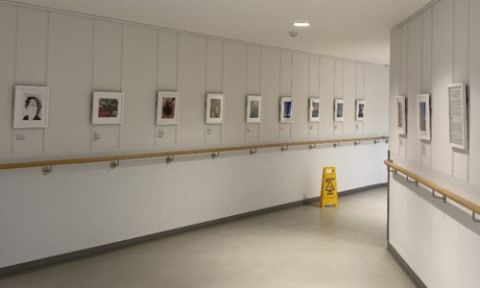Arts for Health, Milton Keynes

By Laura McGrath and Chris Kubiak
We’re writing today about a project in development; an evaluation project with charity Arts for Health Milton Keynes. Their work fits well with this research group. Not only are they based in Milton Keynes University Hospital and are local to The Open University campus, but their work focuses on fostering the health and mental health benefits associated with participation in the arts. They currently offer arts on prescription and arts therapy programmes as well as online resources for children, young people and adults. The focus of our evaluation will be the art collection in Milton Keynes University Hospital which is managed by the charity. It is the largest privately owned art collection in Milton Keynes and is a rich resource of around 450 works made up of paintings, sculpture, prints, murals and textiles. They also manage some of the hospital’s outside spaces called ‘creative courtyards’ which feature sculpture and creative garden design. We aim to understand how the users of the hospital – staff, patients, visiting family and carers experience and use this art collection. Is it more than nice wallpaper?

An association between arts and health is embedded into the history of Milton Keynes University Hospital. For over a decade, the new town of Milton Keynes lacked a hospital. original ‘Milton Keynes is dying for a hospital’ campaign. They created protest sculptures including a large question mark placed at the site (an image replicated on placards) and a large Florence Nightingale puppet.
When the hospital was built, a group of artists set up the Voluntary Hospital Arts Committee which later developed into the current charity.
While arts and health have always gone hand in hand in Milton Keynes University Hospital, it has been more recent that a sustained interest in this relationship has reached the clinical literature. Our examination of existing literature on the impact of art work in healthcare environments revealed that artwork can positively impact how patients perceive the hospital environment and quality of their care, as well as improving mood, reducing pain, restlessness and anxiety.
One mechanism proposed for these relationships is positive distraction. Having something to look at which provides interest beyond the immediate experience of the hospital has been argued to help in both boosting mood and changing the experience of time. One idea is that art helps to 'humanise' the hospital, making it less clinical or threatening and plays a role in "addressing [patients] socially, culturally and existentially as individual human beings". Having art on display can make the hospital seem well resourced and more functional, increasing feelings of safety and security. It’s also practical – art can serve as a way finder helping its staff and visitors find their way around.

The methodological approaches employed to understand the impact on art have been diverse. As the outcomes above suggest, much research sets out to get at the embodied experience of the patient by directly measuring physiological responses such as blood pressure, heart and brain activity. Studies have also looked at analgesic and medication use to capture impact on perceptions of pain and impact on sleep. There is a surprising dominance of laboratory studies compared to studies of the impact of art in situ – on display in the hospital. Naturally, in situ studies will be subject to confounding factors within the hospital environment. A beautiful display of art in a waiting room can be undermined by an overlong wait, for example. But some creative social experiments have been carried out to sidestep these issues. For example, adding and removing art work to a hospital waiting room in order to understand how these different conditions shape the patients’ experience.
Our evaluation aims to examine some of these established relationships and to understand how the collection is experienced by those using the hospital. Most of the literature is on patient outcomes, but we also want to find out how staff view the artworks as well – they, after all, spend the most time in this space. There is also something unique in the history of the hospital, where art has been integrated into the space right from the beginning of its history and in effect plays a role in representing this city to its citizens.
About us
Laura is a Psychology researcher, mainly in areas related to mental health. She has have done previous work looking at arts-based interventions for mental health, both in community, and institutional settings. More broadly, Laura is interested in how material environments shape psychological experiences, including loneliness, mental health, and neurodiversity.
Chris trained in community psychology and subsequently educational research. He is based in the School of Health, Wellbeing and Social Care and has conducted research into health and social care practice and practice-based learning. He is a Trustee of Arts for Health Milton Keynes.
